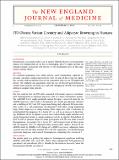FTO Obesity Variant Circuitry and Adipocyte Browning in Humans
Author(s)
Claussnitzer, Melina; Dankel, Simon N.; Kim, Kyoung-Han; Quon, Gerald; Meuleman, Wouter; Haugen, Christine; Glunk, Viktoria; Sousa, Isabel S.; Beaudry, Jacqueline L.; Puviindran, Vijitha; Liu, Jannel; Svensson, Per-Arne; Hsu, Yi-Hsiang; Drucker, Daniel J.; Mellgren, Gunnar; Hui, Chi-Chung; Hauner, Hans; Kellis, Manolis; Abdennur, Nezar Alexander; ... Show more Show less
DownloadKellis_FTO obesity.pdf (1.381Mb)
PUBLISHER_POLICY
Publisher Policy
Article is made available in accordance with the publisher's policy and may be subject to US copyright law. Please refer to the publisher's site for terms of use.
Terms of use
Metadata
Show full item recordAbstract
Background
Genomewide association studies can be used to identify disease-relevant genomic regions, but interpretation of the data is challenging. The FTO region harbors the strongest genetic association with obesity, yet the mechanistic basis of this association remains elusive.
Methods
We examined epigenomic data, allelic activity, motif conservation, regulator expression, and gene coexpression patterns, with the aim of dissecting the regulatory circuitry and mechanistic basis of the association between the FTO region and obesity. We validated our predictions with the use of directed perturbations in samples from patients and from mice and with endogenous CRISPR–Cas9 genome editing in samples from patients.
Results
Our data indicate that the FTO allele associated with obesity represses mitochondrial thermogenesis in adipocyte precursor cells in a tissue-autonomous manner. The rs1421085 T-to-C single-nucleotide variant disrupts a conserved motif for the ARID5B repressor, which leads to derepression of a potent preadipocyte enhancer and a doubling of IRX3 and IRX5 expression during early adipocyte differentiation. This results in a cell-autonomous developmental shift from energy-dissipating beige (brite) adipocytes to energy-storing white adipocytes, with a reduction in mitochondrial thermogenesis by a factor of 5, as well as an increase in lipid storage. Inhibition of Irx3 in adipose tissue in mice reduced body weight and increased energy dissipation without a change in physical activity or appetite. Knockdown of IRX3 or IRX5 in primary adipocytes from participants with the risk allele restored thermogenesis, increasing it by a factor of 7, and overexpression of these genes had the opposite effect in adipocytes from nonrisk-allele carriers. Repair of the ARID5B motif by CRISPR–Cas9 editing of rs1421085 in primary adipocytes from a patient with the risk allele restored IRX3 and IRX5 repression, activated browning expression programs, and restored thermogenesis, increasing it by a factor of 7.
Conclusions
Our results point to a pathway for adipocyte thermogenesis regulation involving ARID5B, rs1421085, IRX3, and IRX5, which, when manipulated, had pronounced pro-obesity and anti-obesity effects. (Funded by the German Research Center for Environmental Health and others.)
Date issued
2015-08Department
Massachusetts Institute of Technology. Computational and Systems Biology Program; Massachusetts Institute of Technology. Computer Science and Artificial Intelligence Laboratory; Massachusetts Institute of Technology. Department of Electrical Engineering and Computer ScienceJournal
New England Journal of Medicine
Publisher
New England Journal of Medicine
Citation
Claussnitzer, Melina, Simon N. Dankel, Kyoung-Han Kim, Gerald Quon, Wouter Meuleman, Christine Haugen, Viktoria Glunk, et al. “ FTO Obesity Variant Circuitry and Adipocyte Browning in Humans .” N Engl J Med 373, no. 10 (September 3, 2015): 895–907. © 2015 Massachusetts Medical Society
Version: Final published version
ISSN
0028-4793
1533-4406